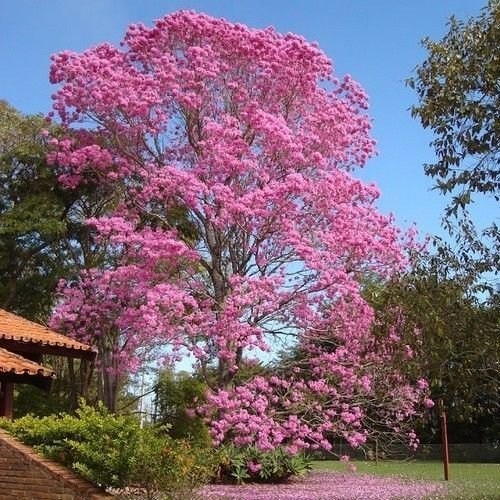
The Tabebuia rosea: A Burst of Pink Trumpet Blooms
The Tabebuia rosea, also known as the Pink Trumpet Tree or Pink Tecoma, is a dazzling sight during flowering. This medium-sized tree erupts in a vibrant display of pink, trumpet-shaped flowers, earning it a well-deserved reputation as a stunning ornamental species.
Botanical Name: Tabebuia rosea Family: Bignoniaceae (Trumpet Vine family)
Origin: Native to tropical and subtropical regions of South America, but widely cultivated in warmer climates worldwide.
Description:
Size: Reaches heights of 10-20 meters with a moderate growth rate.
Foliage: Deciduous (loses leaves in winter), with dark green, compound leaves during the growing season.
Flowers: The star of the show! Large, trumpet-shaped flowers in shades of pink, often with a yellow throat, bloom profusely in clusters during spring and summer.
Fruit: Produces elongated, brown capsules containing winged seeds after flowering.
Climatic Conditions:
Thrives in warm, sunny climates with well-defined wet and dry seasons.
Prefers moderate to high rainfall during the growing season.
Sensitive to frost and requires temperatures above freezing for optimal growth.
Soil Type and Conditions:
Adaptable to various soil types but prefers well-drained, slightly acidic to neutral soil.
Good drainage is crucial to prevent root rot, as the tree is susceptible to waterlogging.
Importance for Biodiversity:
Attracts pollinators like hummingbirds, butterflies, and bees with its nectar-rich flowers.
Provides food and shelter for birds and other small animals.
Contributes to habitat diversity and ecosystem health.
Medicinal Uses:
While some traditional uses in bark and leaves for various ailments exist, extensive research is lacking to confirm their efficacy and safety. Consult a healthcare professional before considering any medicinal use of this plant.
Commercial Uses:
Widely cultivated as an ornamental tree for parks, gardens, streetscapes, and public spaces due to its aesthetic appeal and vibrant flowers.
Timber is used for furniture making and construction in some regions, though not a major commercial use.
Major Insect and Fungal Threats:
Leaf miners: These insects tunnel within leaves, causing discoloration and damage.
Scale insects: Suck sap from leaves, weakening the tree and potentially causing honeydew production and sooty mold growth.
Fungal diseases: Powdery mildew and leaf spot can affect the foliage.
Control Measures:
Preventative measures: Ensure good air circulation around the tree and avoid overwatering.
Encourage beneficial insects like ladybugs and lacewings to control pest populations naturally.
Organic options: Use neem oil spray or insecticidal soap for insect pests.
Fungicides: Use only as a last resort and consult a qualified professional for recommendations.
Additional Information:
The Tabebuia rosea is a relatively low-maintenance tree once established.
It is fast-growing in suitable conditions.
The tree is moderately drought-tolerant once established.
Beware of potential invasiveness in certain regions due to its prolific seed production and fast growth.
Important Note: While the Tabebuia rosea may have some traditional medicinal uses, it's crucial to consult with a healthcare professional before using any part of the plant for medicinal purposes. Self-treatment can be dangerous.